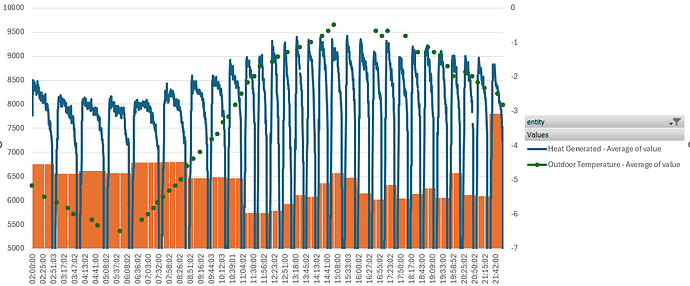I am glad I found this thread. I think I have some interesting additional information on maximum power output of Vaillant Arotherm Plus 7kW in real-world (and challenging) conditions. @glyn.hudson I think I have exactly the case where the installer, in good faith was interpreting the figures in the Vaillant specifications, but not considering that this does not take into account defrost cycles. I have heard that other manufacturers do publish “integrated” power outputs which take into account typical defrost cycles and this seems like it would be very useful.
In my case, the system was designed knowing that it would be somewhat close to the limit, but should not be undersized - we know that we have some opportunities to improve insulation which we plan to do and we do have some backup heating, in the extreme cases.
We had temperatures of -6 overnight recently followed by a foggy day where temperatures only increased to -0.5 max. For the period in the graph below, the pump was running at full capacity for the whole period (120 rps compressor speed whenever not in defrost and no hot water heating). What I am showing is temperature and instantaneous heat power (I cropped the power axis to see details better). I am also showing with the orange area, the average power between the end of one defrost cycle and the end of the next which seemed like a reasonable fair way of representing it, given the changing conditions (ignore the last period as not all of the defrost cycle is included). I have not shown all the data, but for context, the maximum flow temperatures were peaking at about 40-42 and return temperatures 33-35. The flow rate was stable at 912 L/h
At -2 in foggy conditions the output was only averaging about 5.5kW. Overall, it could be roughly summarsed as ~6.5kW during the colder/lower humidity half of the day and ~6kW during the warmer/higher humidity half when defrost cycles were more frequent.
